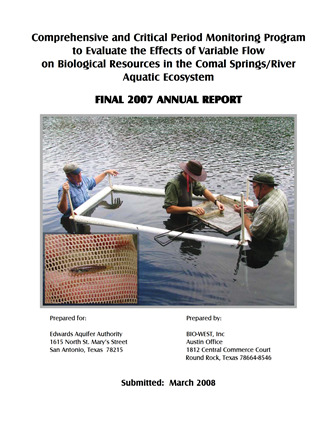Comprehensive and Critical Period Monitoring Program to Evaluate the Effects of Variable Flow on Biological Resources in the Comal Springs/River Aquatic Ecosystem Final 2007 Annual Report

| Summary |
|
The purpose of this report is to document the results of all aquatic ecosystem monitoring conducted in 2007 at Comal Springs located in New Braunfels, Texas. The monitoring and report preparation was performed by BIO-WEST, Inc. Pflugerville, Texas. [Excerpted from the Executive Summary] In 2007, precipitation events during the first half of the year contributed to flows above the historical average for three-quarters of the year. A considerable rain event occurred in July and the flow in the river peaked at 1,980 cfs…. Higher flows following a below average discharge year had a myriad of effects on the biota in the Comal River/Springs Ecosystem. … Aquatic vegetation continued to flourish, but in some reaches non-native plants continued to outcompete native flora…. This may affect fountain darter populations in the future as these fish prefer native vegetation. In addition, another native plant, Cabomba, was no longer observed in [the Upper Spring Run] reach in 2007. Vallisneria was the dominant vegetation in the Landa Lake reach in 2007… The interplay between native and non-native vegetation was observed in this reach in 2007. From fall 2006 to spring 2007 Hygrophila stands in the central portion of the reach swelled, while Ludwigia in this area decreased. By fall 2007, Ludwigia surface area increased, while Hygrophila in the same region decreased. This trend has continued for several years and may have an important effect on fountain darter populations because sampling has shown that darters prefer Ludwigia to Hygrophila…. Drop-netting continues to be the best method for sampling fountain darters in varied vegetation types without harming the endangered fish…. Although flows were higher this year, bryophytes were present throughout much of the Upper Spring Run and Landa Lake reaches. This led to the highest population estimates in these reaches since 2003…. As in previous years data reflected a spring reproduction peak of this species based on length frequency distributions showing the smallest fish present in spring…. Snorkel surveys of salamanders in the spring runs exhibited a slight increase from 2006 with total numbers at or slightly above average…. Fourteen different invertebrate taxa were observed at three drift net sites within Comal Springs in 2007…. In 2007, four different species of Stygobromus were collected within the Comal Springs making it (and the San Marcos Springs) the only locality in North America with four co-occurring Stygobromus species…. Fewer individuals of the Comal Springs riffle beetle (Heterelmis comalensis) were collected in 2007, which was likely related to mechanical disturbance to several of the cotton rags used in capturing them…. [F]urther study is needed to understand the effects of [the gill] parasite at low-flows…. Overall, the higher discharge in 2007 positively affected fountain darter and plant growth. However, it appeared that in some reaches non-native vegetation continues to outcompete the native flora. This may have serious effects on fountain darter populations in certain reaches…. Though the comprehensive portion of the study has been reduced to two annual samples (plus a limited summer effort), it is still adequate to maintain a continuous record of conditions. Maintaining this continuous record is vital since antecedent conditions influence community-level response to reduced discharge conditions. Sampling only during a low-flow event simply does not provide the necessary context to adequately assess changes that occur during such conditions. As such, comprehensive monitoring will continue in the Comal Springs/River ecosystem in 2008. |
Search for Documents
Advance Search
Explore EAA's Scientific Reports
- All Reports
- Overview Studies
- Modeling
- Hydrology and Hydrogeology
- History
- Groundwater Recharge, Recharge Zone
- Groundwater Movement
- Geomorphology and Caves
- Weather Modification
- Geology
- Water Use and Conservation
- Geochemistry
- Water Resources Planning and Management
- Floods and Drought
- Water Quality
- Climatology
- Surface Water / Groundwater Relationship
- Biology
- Springs, Groundwater Discharge
- Archaeology
- RZ Protection
- Aquifer Levels
- Remote Sensing
- Precipitation
